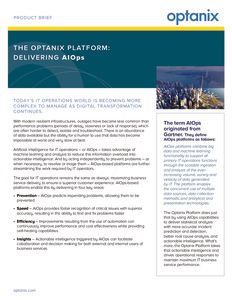
What is the Impact of AI for IT Operations? — Part 1: Optanix on AIOps
Originally intended to stand for ‘algorithmic IT operations,’ AIOps has since evolved to be short for ‘artificial intelligence for IT operations,’ or simply ‘AI for IT operations.’ It is currently among the most exciting emerging areas of IT.
The Rise of Artificial Intelligence for IT Operations
It’s been proven that properly applying AI for IT operations technologies to IT infrastructures that support revenue-generating services and applications provides measurable improvements in business outcomes. As a result, we are on the cusp of a hockey stick in AIOps product growth.
According to Gartner, “by 2023, 30% of large enterprises will be using artificial intelligence for IT operations (AIOps) platforms and digital experience monitoring (DEM) technology exclusively to monitor the non-legacy segments of their IT estates, up from 2% in 2018.”1
The Emergence of AI for IT Operations Management
The emergence of AI for IT operations is timely, as IT infrastructures have attained unprecedented levels of complexity. As their networks have expanded over the decades, global service providers and enterprises have accumulated multiple monitoring tools – it seems like there’s a new tool for every shiny new platform du jour. Unfortunately, having multiple IT monitoring tools inhibits the collaboration that is critical to resolving problems quickly. Navigating multiple tools and dashboards slows an organization’s ability to respond to issues.
AI Operations Tools
AIOps tools and products can distill down the tidal waves of data to isolate problems quickly and provide a consistent view of monitored data – improving collaboration and resolution times. This data-driven analytical approach provides insights and actionable intelligence for IT operations management (ITOM) tools.
In this six-part blog series, titled “Optanix on AIOps”, we’ll provide a look at the legacy and capabilities of AI for IT operations to provide perspective on the role AIOps can play in ITOM today. We will then review in detail how Optanix and other AIOps companies leverage AIOps techniques, among other advanced technologies, to provide proactive IT operations monitoring.
AI’s Impact on ITOM: The Ascension of AIOPs
Artificial intelligence (AI) has been around for decades. The term was first coined to describe an academic discipline way back in the 1950s. AI evolved in fits and starts, but practical applications for the business world began to emerge in the 1980s with the introduction of the first generation of expert systems.
Enter AI for IT Operations
In the new millennium, AI in IT operations has come of age with use cases that are wide-ranging, some of which show promise of making our lives better: robots that can interact with people; smartphones that can recognize speech and respond accordingly; systems that can find victims during disasters; autonomous vehicles that have the potential to drive themselves; and more.
The ascension of AI for IT operations can be credited to a perfect storm, triggered by the unprecedented complexity of IT infrastructures, as described above. The industry has responded to the storm by leveraging a confluence of technological advancements across diverse segments, including:
- The availability of massive computing power
- Affordable data storage
- The scalability of cloud-based infrastructures
- The availability and ability to work with large data sets
- The increased sophistication and capabilities of algorithms
The world of ITOM is one of the many fields that have been swept up in the AI revolution. A wide range of AI technologies are ideally suited to transform the manner in which ITOM is conducted at a fundamental level, including the use of machine learning and advances in data science.
The Application of Artificial Intelligence in IT Operations
The application of AI in the ITOM space has led to the emergence of an exciting new category known as AIOps. Gartner’s definition of artificial intelligence for IT operations is particularly relevant. It describes the platforms and underlying activities that are used to facilitate ITOM:
“AIOps platforms combine big data and machine learning functionality to support primary IT operations functions through the scalable ingestion and analysis of the ever-increasing volume, variety and velocity of data generated by IT. The platform enables the concurrent use of multiple data sources, data collection methods, and analytical and presentation technologies.”2
What AIOps Products Can Do For Your Business
In practice today, AIOps platforms enable data-driven analytical approaches to provide actionable intelligence for ITOM platforms. The benefits range from the detection of infrastructure issues to proactive remediation before issues occur. When coupled with automations, IT operations capabilities can be streamlined, resulting in new levels of predictive maintenance and resource management efficiencies.
How does AIOps product technology deliver on the promise of improved ITOM? The essence of it all is actionable intelligence – essentially, insights that can be acted upon. The table provides a few examples illustrating actionable intelligence and its associated AIOps benefits:
Insights |
Benefits |
| Knowing for certain what is causing a problem, i.e. root cause identification |
|
| Knowing what is affected, i.e. the business impact of a problem |
|
| Anticipating disruptions in advance, i.e. detecting issues before they become incidents and problems |
|
But what are the capabilities an AIOps platform needs to make this possible? We can boil it down to three fundamental capabilities:
- The platform’s ability to ingest vast amounts of data from multiple sources;
- Then, to organize the information in a manner that provides a consolidated dataset upon which analysis can be conducted; and, finally,
- The ability to deliver relevant and precise analytical outcomes that lead to actionable intelligence and better service delivery.
The Optanix AIOPs platform has all these and more.
In our next installment in this series, we break down the capabilities of AIOps tools in IT operations environments.
Learn how you organization can leverage AI and the Optanix Platform to enhance IT operations.

Reference:
- “Use AIOps for a Data-Driven Approach to Improve Insights from IT Operations Monitoring Tools”, Gartner, November 2018.
- “Gartner Market Guide for AIOps Platforms”, Gartner, November 2018.